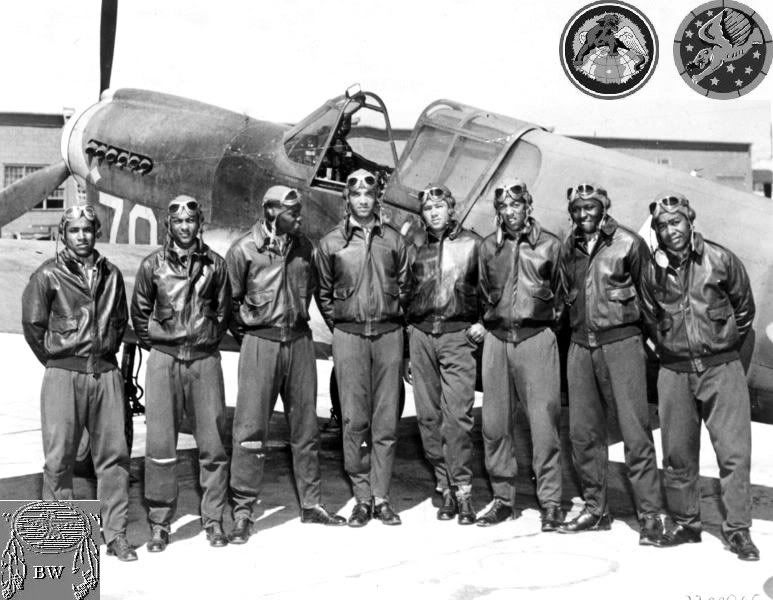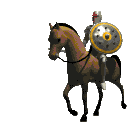Mood:
Now Playing: Wolf Moon by TYPE O NEGATIVE
 Tuskegee Airmen Warriors Citation The 99th was ready for combat duty during some of the Allies' earliest actions in the North African campaign, and was transported to Casablanca, Morocco, on the USS Mariposa. From there, they traveled by train to Oujda near Fes, and made their way to Tunis to operate against the Luftwaffe. The warriors and ground crew were largely isolated by racial segregation practices, and left with little guidance from battle-experienced pilots. Operating directly under the Twelfth Air Force and the XII Air Support Command, the 99th FS and the Tuskegee Airmen were bounced around between three groups, the 33rd FG, 324th FG, and 79th FG. The 99th's first combat mission was to attack the small but strategic volcanic island of Pantelleria in the Mediterranean Sea between Sicily and Tunisia, in preparation for the Allied invasion of Sicily in July 1943. The 99th moved to Sicily while attached to the 33rd Fighter Group,[4] whose commander, Col. William W. Momyer, fully involved the squadron, and the 99th received a Distinguished Unit Citation for its performance in Sicily. The Tuskegee Airmen were initially equipped with P-40 Warhawks, later with P-47 Thunderbolts, and finally with the airplane that they would become most identified with, the P-51 Mustang. On 27 January and 28 January 1944, German Fw 190 fighter-bombers raided Anzio, where the Allies had conducted amphibious landings on January 22. Attached to the 79th Fighter Group, eleven of the 99th Fighter Squadron's warriors shot down enemy fighters, including Capt. Charles B. Hall, who shot down two, bringing his aerial victory total to three. The eight fighter squadrons defending Anzio together shot down a total of 32 German aircraft, and the 99th had the highest score among them with 13. The squadron won its second Distinguished Unit Citation on 12 May-14 May 1944, while attached to the 324th Fighter Group, attacking German positions on Monastery Hill (Monte Cassino), attacking infantry massing on the hill for a counterattack, and bombing a nearby strong point to force the surrender of the German garrison to Moroccan Goumiers. By this point, more warriors were ready for combat, and the all-black 332nd Fighter Group had been sent overseas with three fighter squadrons: the 100th, 301st and 302nd. Under the command of Col. Benjamin O. Davis, the squadrons were moved to mainland Italy, where the 99th FS, assigned to the group on 1 May, joining them on 6 June. The Airmen of the 332nd Fighter Group escorted bombing raids into Austria, Hungary, Poland and Germany. Flying escort for heavy bombers, the 332nd racked up an impressive combat record. Reportedly, the Luftwaffe awarded the Airmen the nickname, "Schwarze Vogelmenschen," or "Black Birdmen." The Allies called the Airmen "Redtails" or "Redtail Angels," because of the distinctive crimson paint on the vertical stabilizers of the unit's aircraft. Although bomber groups would request Redtail escort when possible, few bomber crew members knew at the time that the Redtails were African Americans. While it had long been said that the Redtails were the only fighter group who never lost a bomber to enemy fighters, suggestions to the contrary, combined with Air Force records and eyewitness accounts indicating that at least 25 bombers were lost to enemy fire, resulted in the Air Force conducting a reassessment of the history of this famed unit in the fall of 2006. The claim that the no bomber escorted by the Tuskegee Airmen had ever been lost to enemy fire first appeared on 24 March 1945. The claim came from an article, published in the Chicago Defender, under the headline "332nd Flies Its 200th Mission without Loss." Ironically, this article was published on the very day that, according to the 28 March 2007 Air Force report, some bombers under 332nd Fighter Group escort protection were shot down. The subsequent report, based on after-mission reports filed by the bomber units and Tuskegee fighter groups as well as missing air crew records and witness testimony, was released in March 2007 and documented 25 bombers shot down by enemy fighter aircraft while being escorted by the Tuskegee Airmen. A B-25 bomb group, the 477th Bombardment Group (Medium), was forming in the US but completed its training too late to see action. The 99th Fighter Squadron after its return to the United States became part of the 477th re-designated the 477th Composite Group. By the end of the war, the Tuskegee Airmen were credited with 109 Luftwaffe aircraft shot down, a patrol boat run aground by machine-gun fire, and destruction of numerous fuel dumps, trucks and trains. The squadrons of the 332nd FG flew more than 15,000 sorties on 1,500 missions. The unit received recognition through official channels and was awarded a Distinguished Unit Citation for a mission flown 24 March 1945, escorting B-17s to bomb the Daimler-Benz tank factory at Berlin, Germany, an action in which its pilots destroyed three Me-262 jets in aerial combat. The 99th Fighter Squadron in addition received two DUCs, the second after its assignment to the 332nd FG. The Tuskegee Airmen were awarded several Silver Stars, 150 Distinguished Flying Crosses, 14 Bronze Stars and 744 Air Medals. In all, 992 warriors were trained in Tuskegee from 1940 to 1946; about 445 deployed overseas and 150 warriors lost their lives in training or combat. On 29 March 2007, about 350 Tuskegee Airmen and their widows were collectively awarded the Congressional Gold Medal at a ceremony in the US Capitol rotunda. The medal will go on display at the Smithsonian Institution; individual honorees will receive bronze replicas. The airfield where the airmen trained is now the Tuskegee Airmen National Historic Site. From: historical accounts & records
Tuskegee Airmen Warriors Citation The 99th was ready for combat duty during some of the Allies' earliest actions in the North African campaign, and was transported to Casablanca, Morocco, on the USS Mariposa. From there, they traveled by train to Oujda near Fes, and made their way to Tunis to operate against the Luftwaffe. The warriors and ground crew were largely isolated by racial segregation practices, and left with little guidance from battle-experienced pilots. Operating directly under the Twelfth Air Force and the XII Air Support Command, the 99th FS and the Tuskegee Airmen were bounced around between three groups, the 33rd FG, 324th FG, and 79th FG. The 99th's first combat mission was to attack the small but strategic volcanic island of Pantelleria in the Mediterranean Sea between Sicily and Tunisia, in preparation for the Allied invasion of Sicily in July 1943. The 99th moved to Sicily while attached to the 33rd Fighter Group,[4] whose commander, Col. William W. Momyer, fully involved the squadron, and the 99th received a Distinguished Unit Citation for its performance in Sicily. The Tuskegee Airmen were initially equipped with P-40 Warhawks, later with P-47 Thunderbolts, and finally with the airplane that they would become most identified with, the P-51 Mustang. On 27 January and 28 January 1944, German Fw 190 fighter-bombers raided Anzio, where the Allies had conducted amphibious landings on January 22. Attached to the 79th Fighter Group, eleven of the 99th Fighter Squadron's warriors shot down enemy fighters, including Capt. Charles B. Hall, who shot down two, bringing his aerial victory total to three. The eight fighter squadrons defending Anzio together shot down a total of 32 German aircraft, and the 99th had the highest score among them with 13. The squadron won its second Distinguished Unit Citation on 12 May-14 May 1944, while attached to the 324th Fighter Group, attacking German positions on Monastery Hill (Monte Cassino), attacking infantry massing on the hill for a counterattack, and bombing a nearby strong point to force the surrender of the German garrison to Moroccan Goumiers. By this point, more warriors were ready for combat, and the all-black 332nd Fighter Group had been sent overseas with three fighter squadrons: the 100th, 301st and 302nd. Under the command of Col. Benjamin O. Davis, the squadrons were moved to mainland Italy, where the 99th FS, assigned to the group on 1 May, joining them on 6 June. The Airmen of the 332nd Fighter Group escorted bombing raids into Austria, Hungary, Poland and Germany. Flying escort for heavy bombers, the 332nd racked up an impressive combat record. Reportedly, the Luftwaffe awarded the Airmen the nickname, "Schwarze Vogelmenschen," or "Black Birdmen." The Allies called the Airmen "Redtails" or "Redtail Angels," because of the distinctive crimson paint on the vertical stabilizers of the unit's aircraft. Although bomber groups would request Redtail escort when possible, few bomber crew members knew at the time that the Redtails were African Americans. While it had long been said that the Redtails were the only fighter group who never lost a bomber to enemy fighters, suggestions to the contrary, combined with Air Force records and eyewitness accounts indicating that at least 25 bombers were lost to enemy fire, resulted in the Air Force conducting a reassessment of the history of this famed unit in the fall of 2006. The claim that the no bomber escorted by the Tuskegee Airmen had ever been lost to enemy fire first appeared on 24 March 1945. The claim came from an article, published in the Chicago Defender, under the headline "332nd Flies Its 200th Mission without Loss." Ironically, this article was published on the very day that, according to the 28 March 2007 Air Force report, some bombers under 332nd Fighter Group escort protection were shot down. The subsequent report, based on after-mission reports filed by the bomber units and Tuskegee fighter groups as well as missing air crew records and witness testimony, was released in March 2007 and documented 25 bombers shot down by enemy fighter aircraft while being escorted by the Tuskegee Airmen. A B-25 bomb group, the 477th Bombardment Group (Medium), was forming in the US but completed its training too late to see action. The 99th Fighter Squadron after its return to the United States became part of the 477th re-designated the 477th Composite Group. By the end of the war, the Tuskegee Airmen were credited with 109 Luftwaffe aircraft shot down, a patrol boat run aground by machine-gun fire, and destruction of numerous fuel dumps, trucks and trains. The squadrons of the 332nd FG flew more than 15,000 sorties on 1,500 missions. The unit received recognition through official channels and was awarded a Distinguished Unit Citation for a mission flown 24 March 1945, escorting B-17s to bomb the Daimler-Benz tank factory at Berlin, Germany, an action in which its pilots destroyed three Me-262 jets in aerial combat. The 99th Fighter Squadron in addition received two DUCs, the second after its assignment to the 332nd FG. The Tuskegee Airmen were awarded several Silver Stars, 150 Distinguished Flying Crosses, 14 Bronze Stars and 744 Air Medals. In all, 992 warriors were trained in Tuskegee from 1940 to 1946; about 445 deployed overseas and 150 warriors lost their lives in training or combat. On 29 March 2007, about 350 Tuskegee Airmen and their widows were collectively awarded the Congressional Gold Medal at a ceremony in the US Capitol rotunda. The medal will go on display at the Smithsonian Institution; individual honorees will receive bronze replicas. The airfield where the airmen trained is now the Tuskegee Airmen National Historic Site. From: historical accounts & records Warriors, Places, & Events
Warriors, Places, & Events 
Posted by adjunctprofessor
at 2:48 AM EDT

